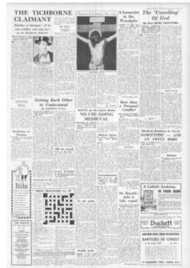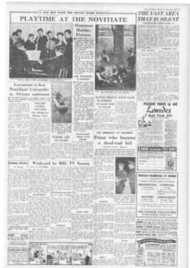Page 6, 5th July 1957
Page 6

Report an error
Noticed an error on this page?If you've noticed an error in this article please click here to report it.
Tags
Share
Related articles
Here's
The Valencia Chalice
Seven Hour Epic On A Spiritual Way
The Cup That Cheers
The Golden Legend Of The Grail
THE REAL CHALICE OF THE LAST SUPPER
• By Fr. Arthur McCormack, ; ; M.A.
Does the ancient quest end in Valencia's Cathedral?
MOST of us have followed in our youth the adventures of the Knights of the Holy Grail, immortalised so romantically by Tennyson. Their exploits were very real to us and appeared almost to he a part of history.. the Holy Grail itself, however. played a very shadowy, mythical part in these stories and I, for one, never dreamed that it had more than a legendary existence.
But. incredible as it may seem. the Holy Grail -the vers chalice used by Our Lord at the Last Supper is venerated at Valencia ill Spain and there is reason to suppose that it is a genuine and very precious relic. In the beatiiifill Chapel of the Holy Grail in the 14th-century Cathedral. this chalice, made of reddish brown agate with a golden stem, is kept in an illuminated reliquary and it is given the official honour reserved for personal relics of Our Lord.
It is, therefore. no mere pious belief about a dubious shrine, no mere legend draws people from all over Spain to this Chapel, hut a well-founded tradition that there, in reality, is the chalice which Our Lord used at the I.ast Supper and in which lie consecrated His own Most Precious Blood.
The chalice, apart from the gold stem which was added later, is of the type used by rich Jews of Our Lord's time and tradition has it that it was in the house of a noble Jew that Our Lord celebrated the Pasch. It is natural to suppose that such an incomparable memorial of Our Lord would he treasured with extreme care, and very probably jt was used when the apostles and the early Christians essembled to celebrate Mass.
This gives a very special significance to the words used immediately prior to the Consecration of the Chalice at Mass: " Accipiens et HUNC praeclarum calicem in sanctas ac fluerabiles mantis suas . • ." ("Taking THIS illustrious chalice in His holy and venerable hands ..."). These words seem to show that the first Consecrations of the Blood of Our Lord took place in the very chalice He had used Himself.
SENT TO SPAIN
HE chalice was brought to
Rome, possibly by St. Peter himself, and was no doubt still used and venerated in the twilight devotions of the Catacombs during the era of persecutions. It remained safe during those turbulent times until the fierce persecution of the Emperor Valerian in the middle of the Third Century. Pope Sixtus II was martyred in this persecution but before he met his death he gave the most precious treasures of the Church, including the chalice, to his deacon, Lawrence, who came from Huesca in
Spain. When Lawrence realised that he was to suffer the same fate as his master. he sent the chalice for safe-keeping to his native town in the year 258 (261) with a covering letter.
The chalice was kept at Huesca for the next few hundred y ears until the Moorish Invasions of the Seventh and Eighth centuries. Audebert, the Bishop of Huesca, was compelled to flee from his sec in 713. He took refuge with the chalice and other belongings. in a mountain named Pan°. where a hermit called Jean de Atarcs lived.
On the site of this hermitage ,a monastery was built called the Monastery of St. Juan de la Pane. It became a centre of resistance to
the Moslem insaders and the exploits of the knights who had their headquarters there became legendary. In fact, they were the origin of the epic stories of Christian of Troyes and Wolfram of Eschenbach, whose hero Parzifal became the Parsifal of Richard Wagner's opera, and from whom ?stator) and Tennyson received inspiration for their sagas of the Knights of the Round Table in the quest for the Holy Grail.
Legend is confirmed by history, for there is an official document extant, dated December 14th 1134, which declares that the chalice in which Our Lord consecrated His Blood was kept at the Monasters of St. Juan de la Pena.
PUBLIC DEVOTION
IN the 14th century, King Martin the Kind of Aragon was greatly desirous of possessing this wonderful relic and he gave the monks a solid gold chalice in exchange for it. The deed of gift, which is preserved in the Archives of the Kings of Aragon in Barcelona. is dated 13th September, 1399. and confirms the story that the chalice was sent to Spain Irons Rome by St. Lawrence.
The chalice was kept for some time in King Martin's palace at Saragossa. Then it came to Valencia in the reign of Alfonso the Magnanimous and remained for a short space of time in the palace of Real on the banks of the river Tuna.
Althought indistinct, we feel that readers will be interested in this picture.
The chalice was finally given to Valencia on 18th March, 1437, where it has been kept. apart from brief interludes necessitated by political circumstances, ever since. This date marked the beginning of public devotion to the " Holy Grail."
By the beginning of the 17th century, annual processions in its honour on a grand scale had been organised and the chalice was venerated publicly on Holy Thursday and Good Friday.
During the Spanish Civil War. Valencia felt the full brunt of the Red Terror. Twenty-two churches were burnt down by the Reds in their hatred of religion and mans priceless works of art and treasures of the past were destroyed even in the Cathedral. The Hols Grail oas smuggled out of the cies with hut a couple of hours to spare. The chapel where it is kept was not badls' damaged except for the ceiling.
This is called the Chapel of the Holy Grail. and it is the only part of the Cathedral in use which dates back to the 14th century. Originally it was used as the lecture room for one of the earliest European universities and St. Vincent Ferrer. a Valencian saint. lectured from the rostrum which can still be seen there. The highlight of the chapel is, however. the beautiful carved work in alabaster on the walls flanking the reliquary of the Holy Grail. This delicate sculpturing depicts scenes from the Old and New Testaments and forms a fitting decoration to the otherwise rather austere setting.
On a recent visit to Valencia I had the privilege of saying the public Mass on Sunday at the altar of the chapel and it was an unforgettable experience to celebrate the Holy Sacrifice within sight of the very chalice which Our Lord Himself had most probably used at the Last Supper.
blog comments powered by Disqus









